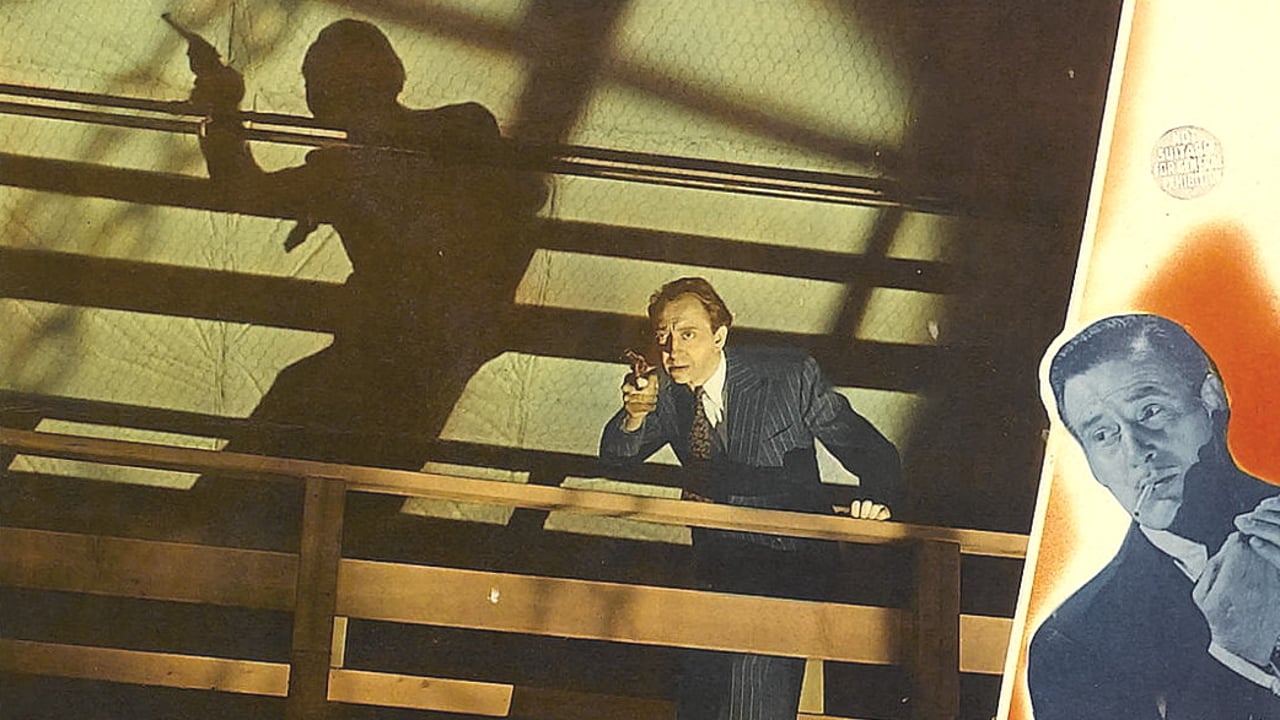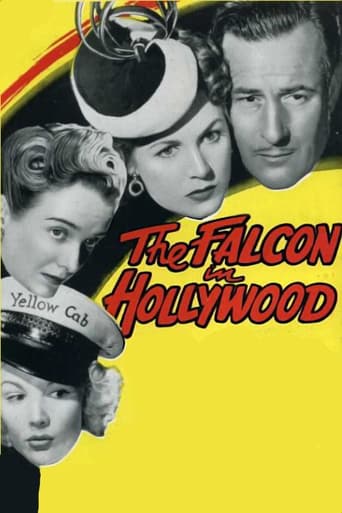

Horrible, fascist and poorly acted
... View MoreGreat visuals, story delivers no surprises
... View MoreBetter Late Then Never
... View MoreA great movie, one of the best of this year. There was a bit of confusion at one point in the plot, but nothing serious.
... View MoreI switched on TCM and watched "The Falcon in Hollywood," a 1944 entry in the series made after George Sanders, the original lead actor in the role, was replaced by Tom Conway (Sanders' real-life brother, though Conway had changed his last name so he wouldn't find the path to success greased by his brother's coattails), a remarkable little movie that's most noteworthy for its plot premise (spoiler alert!), which is the same as "The Producers" only carefully not played for laughs: an unscrupulous Broadway producer, Martin S. Dwyer (John Abbott), best known for dramas — he did a production of "Hamlet" on the Main Stem and proudly displays a poster for it in his office, along with a bust of Shakespeare, whose dialogue he's fond of quoting — comes to the "Sunset Studios" in Hollywood to make his first film. He picks a musical, Magic Melody, and sells 200 percent of the film to various investors, including John Miles, a playboy with a fortune which he's willing to use part of to bankroll a movie so he can act the lead role even though he's never acted before; Alec Hoffman (Konstantin Shayne), a Stroheim-like director with a string of flops behind him; and Louie Buchanan (Sheldon Leonard), a gambler who was imprisoned in New York for fixing horse races but escaped.Tom Lawrence (Tom Conway), nicknamed "The Falcon," is in Hollywood on a vacation when he encounters movie star Lili D'Allio (Rita Corday), a believer in numerology, at a horse race. He also encounters Peggy Callahan (Barbara Hale, a bit of a surprise to see as a baddie since we're used to her role as Della Street in the 1950's Perry Mason TV series), Louie Buchanan's girlfriend; and Billie Atkins (Veda Ann Borg in a great vehicle for her), a lady cabdriver who zips Tom Lawrence around the L.A. streets (playing themselves instead of being safely represented by the RKO backlot) at near-warp speeds. She explains that she's a stunt driver in movies when she isn't working as a cabbie, and her salty performance makes her a considerably more interesting character than the more openly attractive glamour girls the cast abounds in — Hale, Corday and Jean Brooks (Richard Brooks' first wife and the star of the magnificent Val Lewton production "The Seventh Victim") as Roxanna Miles, costume designer for Magic Melody and John Miles' estranged wife, who has the hots for director Hoffman and hopes to marry him — as does D'Allio. There's a lot of running around the "Sunset" lot and the character of an old gatekeeper who becomes a red herring, but eventually Tom Lawrence figures out the whole plot: producer Dwyer was sabotaging his own production, including murdering his leading man, wounding his director with a supposedly blank-loaded gun (and deliberately exposing the day's film, ruining it so that it couldn't be developed and reveal the truth about the attempted murder of Hoffman), and eventually killing Buchanan with a trick ring from India that contains poison in its metal so that as the wearer has it on, the poison is slowly leaching into his system and ultimately knocking him off.The film has some interesting real-life L.A. locations, including a confrontation at the Coliseum as well as an opening scene at the Hollywood Turf Club at which we meet most of the principals, but the most fascinating thing about it is the "Producers" plot element (Dwyer was sabotaging his own film so he wouldn't have to pay off the investors since either it would never be released at all or would fail) done deadly seriously. It was actually an urban legend on Broadway for decades before Brooks filmed it — indeed, Groucho Marx actually wanted to use it as the plot for "A Night at the Opera" but MGM production chief Irving Thalberg vetoed it.
... View MoreTom Conway was one of those natural actors, like Bob Mitchum or Dean Martin, who could stroll through the most low-budget and sometimes unworthy movies without losing his aplomb. Of Conway's Falcon movies this is certainly one of the better ones, but its claim to fame is not another smooth performance from its star but rather the twist at the end. If you don't want to hear it, read no further. I repeat: Stop reading this review. Okay, for the rest of you, let me just say this: Mel Brooks must have seen "The Falcon in Hollywood" before he wrote "The Producers." The big difference is that the Falcon (and the viewer) don't tumble to the shady accountancy until the end, which explains why the investors were killed off.
... View MoreThe Falcon was a character, like The Saint and The Lone Wolf and Boston Blackie, who belonged to the more-American decade of the 1940s. This was the era of individualism in movies, of the private investigator, the lone adventurer, the tough-minded gent who refused to be intimidated by bullies and crime bosses. If the era's screenwriters showed some preoccupation with physical violent potential that led to the denigration of mental toughness in favor of physical courage (during a WWII era), they also produced a few intelligent heroes such as The Falcon. He is a Brit, one who attracts trouble, and women, the way a magnet does iron filings--and who is adept at dealing with both. The part also ably played by his brother George Sanders here is essayed by low-key leading man Tom Conway. The delightful element in this entry in a low-budget fun series is that the producers play the quiet, suave Falcon off Billie", a brassy, talkative and beautiful cabbie entrusted as a role to comedic genius Veda Ann Borg. I find it miraculous that the studio bosses of the time did not notice the potent chemistry between the two characters and make a sequel with Billie as a more streetwise companion to their somewhat-taciturn hero. The other thing that is noteworthy about this story I suggest is that the action which begins at a racetrack with the old 'switched handbag routine" leads to multiple murders at a movie studio; studio-based and later location-based problems with a production headed by Shakespeare-quoting dour John Abbott help to make possible some clever character revelations, and the eventual unraveling of an intricate mystery of motivations, mayhem and secrecies. Among others in the extraordinary "B" film cast are able Sheldon Leonard, lovely Barbara Hale (later of "Perry Mason" TV fame), Rita Corday (aka Paulie Crozet), Konstantine Shayne as a nasty director, Jean Brooks in an intelligent role, and Emory Parnell and Frank Jenks as befuddled policemen.. All are very adequate at doing whatever is asked of them. This is a low-budget production all the way, of course; only localizing it in a movie studio's existing soundstages and sets obscures this fact. The location jaunt is a delight, featuring a swimming pool area and additional zones, and the racetrack sequence is also very ably directed by action-film great Gordon Douglas.. Technical credit should be given to the sound department and to Renie for her fine costumes also. This was in its day a "programmer", a story enlivened by good and by cheap touches of inspiration. But anyone who dares to call it dated needs to look at the post 1972 filmmakers' 99% fizzled blockbusters consisting of inadequate acting, special effects and missed script opportunities, This is the best of the Falcon series, and from my perspective as a writer, that is rather a proud accomplishment in the area of providing entertainment on the cinematic screen.
... View MoreI was watching this movie on the hangar deck of the USS Yorktown in Ulithi lagoon in the Western Caroline islands in 1945. I remember a scene at a swimming pool. Then a Kamikaze struck the Randolf, an aircraft carrier anchored next to us. The movie was stopped and we went to battle stations. I have tried to locate a copy of this movie so that I could see the ending with no luck.
... View More